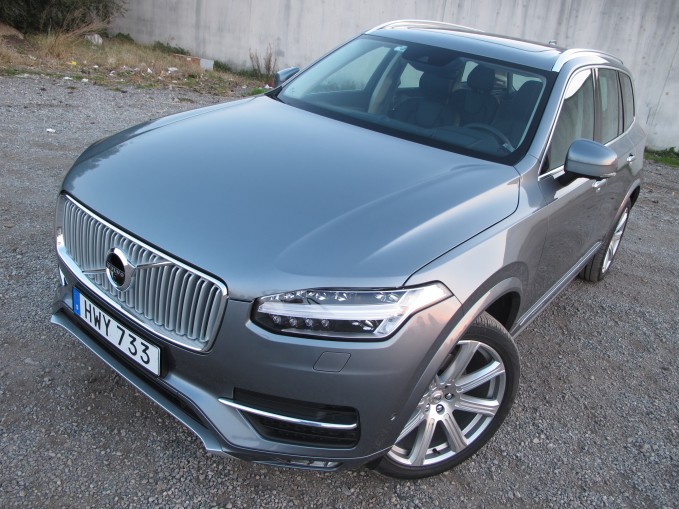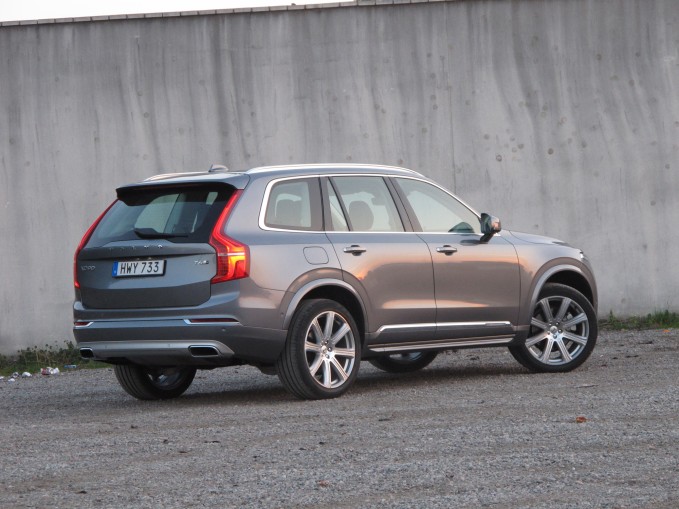What’s new with the new 2016 Volvo XC90? Everything from the platform to the powertrain to the badge on the grille.
The XC90 is the culmination of an $11 billion investment by Chinese parent Geely, which bought the Swedish automaker back in 2010 and it’s our first glimpse at the brand’s future: They plan to re-do every car in their lineup by 2020.
The arrow on the Volvo logo now points the same direction as the diagonal line across the grille, which should be a huge relief to those with obsessive-compulsive tendencies.
Having a Boxy Body Never Looked so Swede
The first thing people will notice about the XC90 is the new shape: It’s boxy and more angular than other Volvo SUVs and almost daring by Swedish standards. Volvo styling tends to age well — the outgoing XC90 has hardly changed since its 2002 introduction and it still looks fresh — so we hope the new XC90 will look just as good in ten years.
In the interest of fuel economy, Volvo is swearing off engines with more than four cylinders and sure enough this 4,600 lb. behemoth has a mere two liters under the hood. Mission impossible, you say? Yeah, we thought so too, but we were surprised to find that the XC90 moves as if its powered by an engine twice the size. Were it not for the characteristic four-cylinder buzz, we’d be hard pressed to guess there was anything other than a stout V6 under the hood.
Two Charges We Wouldn’t Want Dropped
What actually lives under the hood is the 316 horsepower Drive-E T6 engine, introduced in the 2015 60-series cars. Volvo’s secret sauce comes in the form of a combined supercharger-turbocharger setup. At low engine speeds, power is boosted by an engine-driven supercharger; as the engine spins faster, it switches over to an exhaust-driven turbocharger. The idea is to eliminate turbo lag (the low-RPM hesitation that plagues most small turbocharged engines) and in the XC90 it works like crazy: 0-60 in 6.1 seconds, according to Volvo and passing acceleration with no waiting — and all this with standard all-wheel drive. Our one complaint about the engine is that it rattles like a diesel at idle and at low RPM.
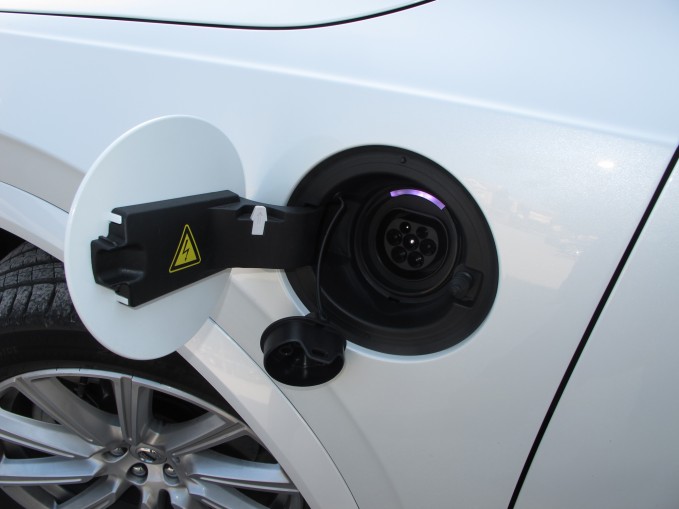
EPA fuel economy figures were not available at the time of our test drive; Volvo claims a 59 MPGe (mile per gallon equivalent) figure for the T8 on the EPA combined city cycle, based on a combination of gas and electric power — but that figure is pretty much meaningless, as it assumes that full-electric power is always available (which it won’t be after a couple dozen miles). As for the T6, Volvo will only say that it expects “best-in-class” MPG, which we expect means low- to mid-20s in the EPA combined cycle — and that’s a figure we can live with.
Infotainment Done Right
The powertrain impressed us, but it was the XC90’s interior that we really fell in love with. The main attraction is Volvo’s new Sensus system, a vertically oriented touch-screen that replaces almost all of the buttons and dials normally used for secondary controls. We’ve encountered more than our share of confusing systems, but Volvo has a new and better idea: The control system works like a tablet computer. The screen has four horizontal zones (navigation, stereo, climate and a user-selectable section), all of which can be expanded for a detailed view. The system uses familiar gestures — tapping, swiping, 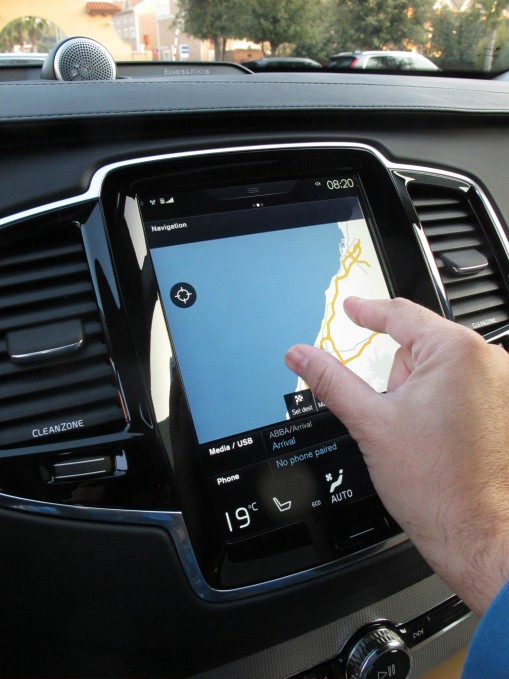
artphone, you can use Sensus. It’s a brilliant execution and the fact that everything is software-driven allows Volvo to tweak the user interface with updates coming in over the XC90’s built-in WiFi connection as needed.
The instrument panel is a large video screen that features an image of an analog speedometer and a tachometer or power meter, depending on driving mode. The center of the screen can display a full-color moving map; disable it and the gauges grow slightly larger. The cars we tested had an optional ($900) full-color head-up display, which projects speed, speed limits and next-turn directions in the windshield.
Venerable Interior Execution
All of this electronic wizardry is wrapped up in an interior that is beautifully executed, even by Volvo’s lofty standards. There’s an emphasis on high-quality materials, with leather and genuine wood or metal at most of the touch-points. T8 models get a nifty crystal shifter and both T6 and T8 put their own twist on the engine start/stop button — it’s actually a rotary switch that turns one way to power up the car and the other to shut it down.
Volvo is well known for their supremely comfortable seats and the XC90 is no exception. Leather upholstery is standard and there’s an optional extendable thigh bolster that provides good support for taller drivers. Combine this with a tilt-telescope steering column (surprisingly, not power operated) and big windows and any driver can find a comfortable and commanding driving position.
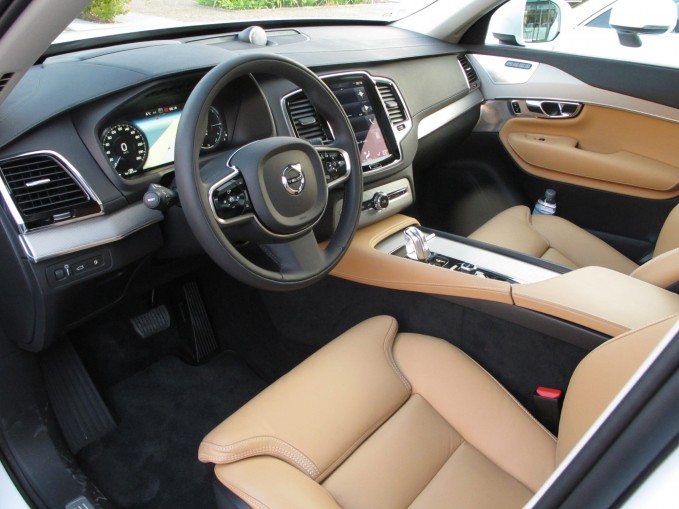
Cargo space with all three rows in place is 15.8 cubic feet, enough for groceries and small suitcases. The third row folds in two sections and the second row folds in three. Maximum cargo space is 85.7 cubic feet, with a flat load floor.
Payment, Please
Volvo plans to offer the XC90 in Momentum, Insignia and R-Design trim, the latter tuned for more aggressive handling. At the time of our test drive, prices hadn’t been been announced for the T8 plug-in hybrid version, but we were told that the T6 Momentum models would start at $48,495 (including a $995 destination fee), Insignias at $55,495 and R-Designs at $51,895. For our press preview, Volvo supplied T6 and T8 Insignia models, the former optioned up to $63,950 (and the latter unmarked). All of the XC90s we drove had the $1,800 air suspension, which provides a comfortable, quiet ride and lean-free cornering. Hard as we pushed, we could barely get a hint of tire squeal out of the XC90; then again, air suspensions rarely put a tire wrong, so we will have to drive a steel-spring version before we cast our final verdict. Steering is electric and it felt firm and well-connected.
Safe Assumptions
We can’t review a Volvo without discussing safety. It’s a subject with which Volvo is nearly obsessed, the company having pledged that by 2020, no one will die or be seriously injured in a new Volvo. (We suggested they mount missiles to the car as an expedient way to accomplish this. The Swedes did not find this funny.)
The XC90 starts with the usual high-strength-steel body cage and airbags, airbags everywhere. Standard equipment includes Volvo’s City Safety collision mitigation system, which can detect an imminent collision and apply the brakes, reducing the severity or (at low speeds) stopping the car altogether. The XC90 gets an updated version; it now protects the car during left turns — that is, if you’re about to turn left and an oncoming car is bombing straight for you, it’ll apply the brakes so you can’t turn into the other car’s path. The system also detects cars approaching too quickly from the rear and flashes the hazard lights to get the other driver’s attention. If the XC90 is about to be rear-ended, it will tighten the seatbelts and pre-charge the brakes. The car also tightens the belts if you drive off the pavement at speed, which can reduce the severity of spinal injuries.
The XC90 also offers blind-spot warning with cross traffic alert and lane departure warning and correction, though they are on the options list, along with a 360-degree camera that helps with parking. Not that you’ll necessarily need it, as the XC90 offers a self-parking system that can park the car in either parallel or perpendicular spots (the driver works the gas, brake and shifter and the car steers itself into the spot). Unlike other self-parking systems, this one will also get you out of the spot — helpful, as these systems can often squeeze you into spots that are difficult to get out of.
The Verdict:
All in all, we’re very, very impressed by the new XC90. All of the attributes we expect from a Volvo – safety, pract
icality and… er… well, more safety — are intact, while the high-class interior, innovative powertrain and smart Sensus touch-screen control system launch the XC90 right to the cutting edge. If this is the future of Volvo, then luxury brands like Audi, Mercedes, Lexus and BMW had better watch their backs.







